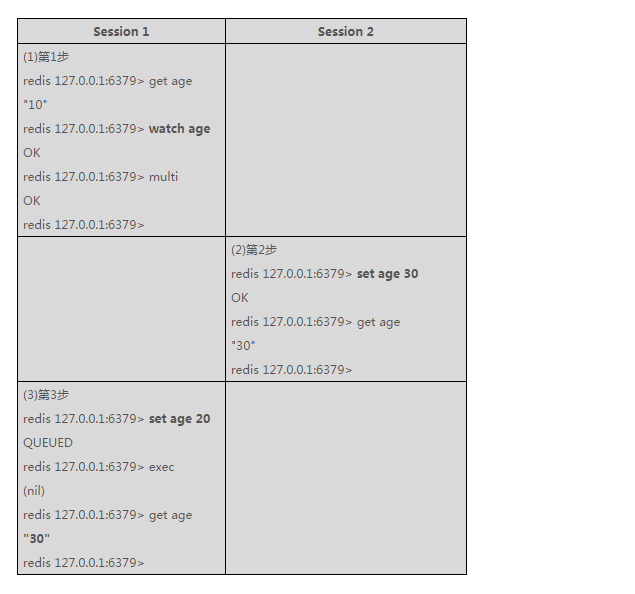最近有一个竞拍的项目会用到分布式锁,网上查到的结果是有三种途径可以实现。1.数据库锁机制,2.redis的锁,3.zookeeper。考虑到使用mysql实现会在性能这一块会受影响,zookeeper又是不怎么会。所以使用redis来实现了。
第一种:使用redis的watch命令进行实现

如上图所示:session1在执行修改之前使用watch命令监视了age,然后又在session2更新了age之后,session1在执行exec,在该命令执行的时候应该会检查age值是否更改,现在是已经发生了改变,所以返回执行失败。
基于上述图示写了一段java代码
import redis.clients.jedis.Jedis; import redis.clients.jedis.Transaction; import java.util.List; public class RedisWatchTest extends Thread { private String auctionCode; public RedisWatchTest (String auctionCode) { super(auctionCode); this.auctionCode = auctionCode; } private static int bidPrice = 100; public static void main(String[] args) { System.out.println(Thread.currentThread().getName() + "主线程运行开始!"); //更改key为a的值 Jedis jedis=new Jedis("127.0.0.1",6379); jedis.set("goodsprice","0"); System.out.println("输出初始化值:"+jedis.get("goodsprice")); jedis.close(); RedisWatchTest thread1 = new RedisWatchTest("A001"); RedisWatchTest thread2 = new RedisWatchTest("B001"); thread1.start(); thread2.start(); try{ thread1.join(); thread2.join(); }catch(InterruptedException e){ e.printStackTrace(); } System.out.println(Thread.currentThread().getName() + "主线程运行结束!"); } @Override public void run() { System.out.println(Thread.currentThread().getName() + "线程运行开始 "); Jedis jedis=new Jedis("127.0.0.1",6379); try { if(Thread.currentThread().getName()=="B001"){ sleep(1000); } } catch (InterruptedException e) { e.printStackTrace(); } //监视KEY jedis.watch("goodsprice"); //A先进 String v = jedis.get("goodsprice"); Integer iv = Integer.valueOf(v); //条件都给过 if(bidPrice > iv){ Transaction tx = jedis.multi();// 开启事务 Integer bp = iv + 100; //出价成功,事务未提交 tx.set("goodsprice",String.valueOf(bp)); System.out.println("子线程" + auctionCode + "set成功"); try { if(Thread.currentThread().getName()=="A001"){ sleep(2000); } } catch (InterruptedException e) { e.printStackTrace(); } List<Object> list = tx.exec(); if (list == null ||list.size()==0) { System.out.println("子线程" + auctionCode + ",出价失败"); }else{ System.out.println("子线程"+this.auctionCode +", 出价:"+ jedis.get("goodsprice") +",出价时间:"
+ System.nanoTime()); } }else{ System.out.println("出价低于现有价格!"); } jedis.close(); System.out.println(Thread.currentThread().getName() + "线程运行结束"); } }
执行结果:
main主线程运行开始!
输出初始化值:0
B001线程运行开始
A001线程运行开始
子线程A001set成功
子线程B001set成功
子线程B001, 出价:100,出价时间:76269463819581
B001线程运行结束
子线程A001,出价失败
A001线程运行结束
main主线程运行结束!
上述代码是在主线程里面开了两个子线程,首先让B001先等待1s时间,让A001先watch最高价,然后在A001事务exec之前让他等待2s时间。这个时候B001已经出价成功了,所以最后应当返回A001出价失败。
第二种:使用redis的setnx命令进行实现
关于setnx的详解参考的是下面这个文章,拿了他的两个加锁和解锁的正确实现方式。
https://www.cnblogs.com/linjiqin/p/8003838.html
下面是通过setnx实现的相关代码
import redis.clients.jedis.Jedis; import java.util.Collections; /** * @author chen * @date 2018/4/30 16:09 */ public class RedisSetNXTest extends Thread{ private static final String LOCK_SUCCESS = "OK"; private static final String SET_IF_NOT_EXIST = "NX"; private static final String SET_WITH_EXPIRE_TIME = "PX"; private String auctionCode; public RedisSetNXTest (String auctionCode) { super(auctionCode); this.auctionCode = auctionCode; } private static int bidPrice = 100; public static void main(String[] args) { System.out.println(Thread.currentThread().getName() + "主线程运行开始!"); //更改key为a的值 Jedis jedis=new Jedis("127.0.0.1",6379); jedis.set("goodsprice","0"); System.out.println("输出初始化值:"+jedis.get("goodsprice")); jedis.close(); RedisSetNXTest thread1 = new RedisSetNXTest("A001"); RedisSetNXTest thread2 = new RedisSetNXTest("B001"); thread1.start(); thread2.start(); try{ thread1.join(); thread2.join(); }catch(InterruptedException e){ e.printStackTrace(); } System.out.println(Thread.currentThread().getName() + "主线程运行结束!"); } @Override public void run() { System.out.println(Thread.currentThread().getName() + "线程运行开始 "); Jedis jedis=new Jedis("127.0.0.1",6379); try { if(Thread.currentThread().getName()=="B001"){ sleep(1000); } } catch (InterruptedException e) { e.printStackTrace(); } //让A先拿到锁 boolean isOk= tryGetDistributedLock(jedis, "goods_lock", Thread.currentThread().getName() , 10000); try { if(Thread.currentThread().getName()=="A001"){ sleep(2000); } } catch (InterruptedException e) { e.printStackTrace(); } if(isOk) { System.out.println("子线程"+this.auctionCode +"拿到锁"); String v = jedis.get("goodsprice"); Integer iv = Integer.valueOf(v); //条件都给过 if(bidPrice > iv){ Integer bp = iv + 100; //出价成功,事务未提交 jedis.set("goodsprice",String.valueOf(bp)); System.out.println("子线程"+this.auctionCode +", 出价:"+ jedis.get("goodsprice") +",出价时间:"
+ System.nanoTime()); }else{ System.out.println("出价低于现有价格!"); } boolean isOk1= releaseDistributedLock(jedis, "goods_lock", Thread.currentThread().getName()); if(isOk1){ System.out.println("子线程"+this.auctionCode +"释放锁"); } }else{ System.out.println("子线程" + auctionCode + "未拿到锁"); } jedis.close(); System.out.println(Thread.currentThread().getName() + "线程运行结束"); } /** * 尝试获取分布式锁 * @param jedis Redis客户端 * @param lockKey 锁 * @param requestId 请求标识 * @param expireTime 超期时间 * @return 是否获取成功 */ public boolean tryGetDistributedLock(Jedis jedis, String lockKey, String requestId, int expireTime) { String result = jedis.set(lockKey, requestId, SET_IF_NOT_EXIST, SET_WITH_EXPIRE_TIME, expireTime); if (LOCK_SUCCESS.equals(result)) { return true; } return false; } private static final Long RELEASE_SUCCESS = 1L; /** * 释放分布式锁 * @param jedis Redis客户端 * @param lockKey 锁 * @param requestId 请求标识 * @return 是否释放成功 */ public boolean releaseDistributedLock(Jedis jedis, String lockKey, String requestId) { String script = "if redis.call('get', KEYS[1]) == ARGV[1] then return redis.call('del', KEYS[1])
else return 0 end"; Object result = jedis.eval(script, Collections.singletonList(lockKey), Collections
.singletonList(requestId)); if (RELEASE_SUCCESS.equals(result)) { return true; } return false; } }
执行结果:
main主线程运行开始!
输出初始化值:0
A001线程运行开始
B001线程运行开始
子线程B001未拿到锁
B001线程运行结束
子线程A001拿到锁
子线程A001, 出价:100,出价时间:77389730033100
子线程A001释放锁
A001线程运行结束
main主线程运行结束!
同样代码是在主线程里面开了两个子线程,先让B001等待,让A001先去拿到锁。然后让B001在没有拿到锁的情况下去操作redis,代码做出判断该现场未拿到锁,后执行的A001因为拿到了锁,所以可以进行出价。
这两种方式实现应该都是属于乐观锁吧,上述实现可能暂时不适应什么秒杀之类的并发环境。总之具体问题还是得具体分析吧。